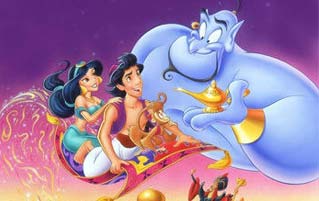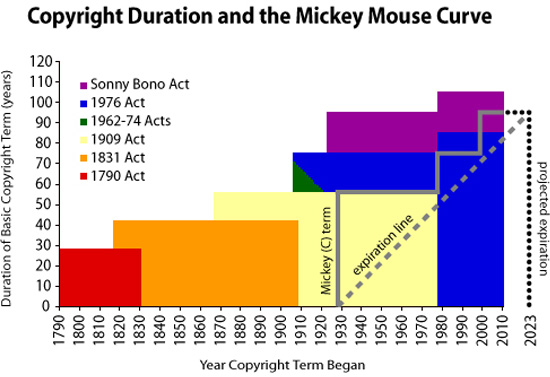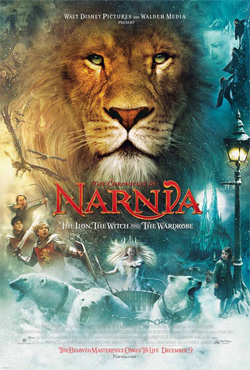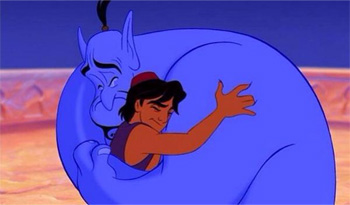5 Insane Jerk Moves You Never Knew Disney Pulled

The world is full of companies that, given the legal green light, would tap brain fluids right out of your skull if they thought it would improve their bottom line. And one company in particular has gotten away with crazyballs levels of asshattery because no one was paying attention to them: Disney.
Yes, that Disney -- the company responsible for 64 percent of all the joy you've ever experienced. Here's a list of sins even Jiminy Cricket couldn't absolve ...
Disney's "Injured Guest" Park Policy Used To Be Insane
With so many people visiting Disney theme parks every day, accidents can happen. These risks can be mitigated with things like proper maintenance and risk management, but it turns out Disney hasn't always been super great at that. For instance, in 2003, the Big Thunder Mountain Railroad derailed, killing a rider. It was later found that maintenance crews signed off on paperwork showing the ride was safe, despite an ominous clanking sound. In 2016, an alligator killed a toddler playing on a beach belonging to the Grand Floridian Resort & Spa. Employees had repeatedly warned management about gators in the area, and been warned themselves about the dangers of feeding the things. Disney responded with some signs and a fence and, uh, surreptitiously benching all gator-themed cartoon characters.

But Disney's hid more than cartoon reptiles. We're talking about concealing injured people, to the extent that they'd do everything short of disappearing your broken body into the hyena den in order to prevent the sight of some paramedics from killing everyone's buzz. For instance, in 2000, nine riders were seriously injured on Space Mountain when a car jumped the track. In the aftermath, a report by the fire service noted that Disney employees conspired to keep news of the incident "as stealthy as possible" by only giving scant details over the radios, which contributed to a delayed medical response. Which is of course the last thing you'd want when there's a chance your final moments could be scored to the never-ending chorus of It's A Small World.

On that occasion, no one died, but others haven't been so lucky. In 1981, a teenager was stabbed at Disneyland. Instead of calling an ambulance, Disney piled him and the resident nurse into the back of an unmarked van and drove him to the hospital, where he later died of his injuries. Although there was some debate over whether his wounds were survivable in the first place, it's fair to say that their first port of call should have been trained professionals instead of a nurse more accustomed to treating nosebleeds and cotton-candy-induced nausea.
In another incident, a tourist was killed in 1998 when a metal cleat attached to a boat ride broke free and struck him in the head, ripping away his jaw. Before the police could get there, Disney staff had cleaned up the bloody scene ("out of courtesy to our guests") and bagged up vital pieces of evidence that didn't find their way to the police for another four days.

Anyways, good news, because it's now safe to get injured on Disney property. They overhauled their policy after a four-year-old boy was pinned underneath a Roger Rabbit ride for ten agonizing minutes.
The Magic Kingdom Is More Or Less A Separatist Nation
When Walt Disney was scouting locations for Disney World, he had a problem. If the local landowners discovered that he was buying up masses of land in the region, prices would rise astronomically. In order to work around this, he set up a series of dummy corporations with pun names (the M T Lott Co., for instance) and made the purchases through them, allowing him to buy over 40 square miles for less than $200 an acre.

With the land in their possession, Disney then needed a way to do whatever they wanted with it without The Man meddling in their affairs. So by teaming up with actual fucking CIA agents (who know a thing or two about dealing with troublesome governments), they managed to strike a deal with the government which transformed the area into a regulation-free zone known as the Reedy Creek Improvement District. Effectively a self-governing fiefdom, the local board handles building code regulations, emergency services, energy policy, public services, and maintains the highways and waterways. Florida collects property taxes, and that's about it. In 2005, the chief of Florida's Bureau of Fair Rides Inspection observed that the state couldn't even shut down the rides.
Despite seceding from the Union, however, Disney loves to interfere in politics, particularly when it concerns their bottom line. They're a member of the National Restaurant Association, a trade association group which pushes against potential minimum wage hikes and changes in sick/vacation pay allowances. Between 2015 and 2016, they spent $7.75 million on federal lobbying to defend mouse-related interests. Interests like the time they colluded with government officials in Florida to shut down a vote that would allow their workers to collect sick pay.

Here's another fun one: In the aftermath of 9/11, Disney successfully lobbied for their parks to be classified as no-fly zones. This was nominally because they were concerned they would be targeted by future terrorist attacks, which is the reason no-fly zones are implemented for government facilities. But they're meaningless if not backed up with physical force, which Disney doesn't have (unless there are Disney-branded SAMs lurking in Cinderella's Castle). The real reason Disney wanted them is that a no-fly zone prohibits tour groups and sky advertisers from flying over a park, which the company'd had a hate-boner about for years. And while that might seem like the kind of modest intrusion into national security policy we expect all entertainment corporations to make, it's led to one hilarious consequence: Disney now has to lobby the FAA to exempt them from their own no-fly zones so that they can fly swarms of drones in heavily populated areas.
Oh, one last thing. Disney is also able to rewrite copyright law more or less at will. Under the 1909 Copyright Scheme, the copyright on Steamboat Willy -- and therefore Mickey Mouse -- would have expired in 1984. Thanks to Disney's lobbying efforts, however, Congress implemented a new act in 1976 which retroactively extended the copyright until 2003. Then another canny bit of lobbying in 1993 saw him free from our clutches until 2023.

"So what?" you might ask. "Is Cracked pissed they can't sell the erotic Mickey Mouse stories they've been writing these long years?" (Short answer: YES.)
Their Intern Program Is Basically Indentured Servitude
You may be aware that Disney has an intern program that accounts for 12,000 or so members of its payroll, who work everything from the rides to the restaurants to hunting the animatronic Millard Fillmore whenever he escapes from the Hall of Presidents. When the employee union originally agreed to this internship program, they were told that it'd only be used to alleviate stress during the busier seasons. Of course, the exact opposite of that happened, and now students and recent graduates are being used as an ever-cycling pool of park labor.
Mind you, the interns aren't undeserving of sympathy, in that they're still working grueling (and educationally dubious) 12-hour shifts cleaning up rainbow-colored vomit. They also do it without sick days, can have their person and possessions searched at any time, and they can be evicted. That's right, evicted. They live in student-esque accommodations, like residents of an old-timey company town -- a privilege for which they pay rent to Disney.

And if you're a full-time worker there? We've talked before about the horrors endured by costumed characters who work in the House of the Mouse, from the communal underwear to getting perpetually punched in the junk by jovial children. But it turns out there are other jobs there. Those rides aren't powered by fairy dust and wishes; it takes an entire data center full of trained professionals monitoring computers to prevent everything from turning Westworld. It's an important job, so when several hundred of these employees were called into a management meeting, they probably weren't expecting to be told that they were being laid off and replaced with lower-paid foreign workers. And then told to train those very same workers.

They've Always Had A Huge Animal Abuse Problem
At least Disney loves animals, right? It'd be hard for them not to, when every film they make is crammed full of nature's cutest wise-crackers. Even if they didn't, it'd take a special type of bastard to turn a children's cartoon studio into a vehicle of nature-maiming horror.

In order to make 2008's Snow Buddies, Disney needed two things: a screenwriter who'd given up on their dreams, and lots and lots of puppies. Extra puppies, in fact, in case any died during filming. Which five of them did. Around 40-50 other animals also fell ill during the production. It wound up being such a slaughterhouse that the American Humane Association wouldn't allow the movie to use its trademark "No animals were harmed" message in the credits -- permission which they will give to basically anyone.
And that's not the only animal-related mishap to occur when making a Disney film. According to another report by the AHA, a trainer on Eight Below was forced to break up a fight between a group of dogs by repeatedly punching one in the diaphragm, whilst The Chronicles of Narnia: Prince Caspian was basically a glue factory, with horses constantly being rotated out of filming because of wounds and array of medical maladies.

The Pirates Of The Caribbean series is a particular bugbear to Mother Nature. During the filming of the first movie, a series of underwater explosions resulted in swathes of dead fish washing up on shore. The production denied that the explosions and deaths were related, presumably coming short of suggesting they'd witnessed an aquatic suicide cult. The latest movie has also been criticized for transporting two Capuchin monkeys halfway across the world, despite the fact that most animal welfare groups agree that the distress this would cause is the worst thing that they could do to the poor things.

It'd be easy to blame this on modern movie-making methods, but that wouldn't be true at all; Disney has never given a shit about animals. Consider 1958's White Wilderness, i.e. the reason you think lemmings commit suicide. According to the movie, the filmmakers witnessed a subarctic lemming population migrating across the frozen landscape of Canada, only to end it all by throwing themselves into a river. But in truth, the "migration" scenes were filmed using a giant snow-covered turntable, and when that didn't work, simply herding them. As for the suicide scenes, they were achieved by picking the poor critters up and lobbing them off a cliff. If it makes you feel any better, the filmmakers got their just desserts: winning the Academy Award for Best Documentary.
They Back-Stabbed Robin Williams Over Aladdin
In 1991, Robin Williams was riding high. Following a series of box office disasters, Disney had given him a chance at redemption with a specially crafted starring role in Good Morning, Vietnam, a movie which would ultimately go on to rake in enough money and goodwill to completely make up for the real war in Vietnam. By way of thanks, he agreed to lend his voice to some pokey little animation project they had going.

Williams had a single caveat: In return for working standard voice actor scale ($75,000), he asked that marketing not make a big deal of the fact he was voicing Genie. Why? Because his pet project Toys was being released around the same time, and he feared that it'd be crushed with his name at the helm of a Disney movie. The deal -- which meant no print or television adverts featuring Robin Williams' name or image -- was swiftly agreed to by Disney.
But as Williams recorded and ad-libbed his way through production, the makers of Aladdin upped his role from a supporting character to a major player. To make matters worse, test screenings conclusively showed that Genie was the audience's favorite character. Disney was in a tough spot. Eventually, they were able to wear Williams down. He agreed to be featured in adverts, so long as he only took up 25 percent of the space. "Perfect," replied Disney. "Wish granted*."

In a move that was more "evil genie who takes everything literally" than "friendly genie who abides by the spirit of a deal," Disney released a poster in which Genie overshadowed every other character in the movie, and yet didn't take up more than 25 percent of the space. Considering this and numerous other advertisements he'd discovered featuring only Genie, Williams complained to Disney about their betrayal. Their response was a politely worded eff-off and a salacious piece of gossip released to the media that Williams was refusing to participate in marketing because he was throwing a tantrum about his paycheck.
It was petty as shit, basically. Williams refused to voice Genie for the direct-to-video sequel or spinoff TV series, and while there were apologies and reunions of sorts over the years, the relationship was never entirely repaired. Williams reportedly even left instructions in his will that none of his voice material on the cutting room floor from the first Aladdin could ever be used to make another movie.

Follow Adam on Twitter! He also has a Facebook page, but that's only for the coolest kids. You wouldn't be interested.
For more evidence that Disney is more or less staffed with crazy supervillains, check out 6 Things Nobody Tells You About Working at Disney World and 22 Disturbing Facts Disney Doesn't Want You to Know.
Subscribe to our YouTube channel, and check out Disney Thinks You Hate Poor People, and other videos you won't see on the site!
Follow us on Facebook, and we'll follow you everywhere.
Want to know how to go mano-a-mano with a president? Daniel O'Brien can help with How to Fight Presidents: Defending Yourself Against the Badasses Who Ran This Country.
